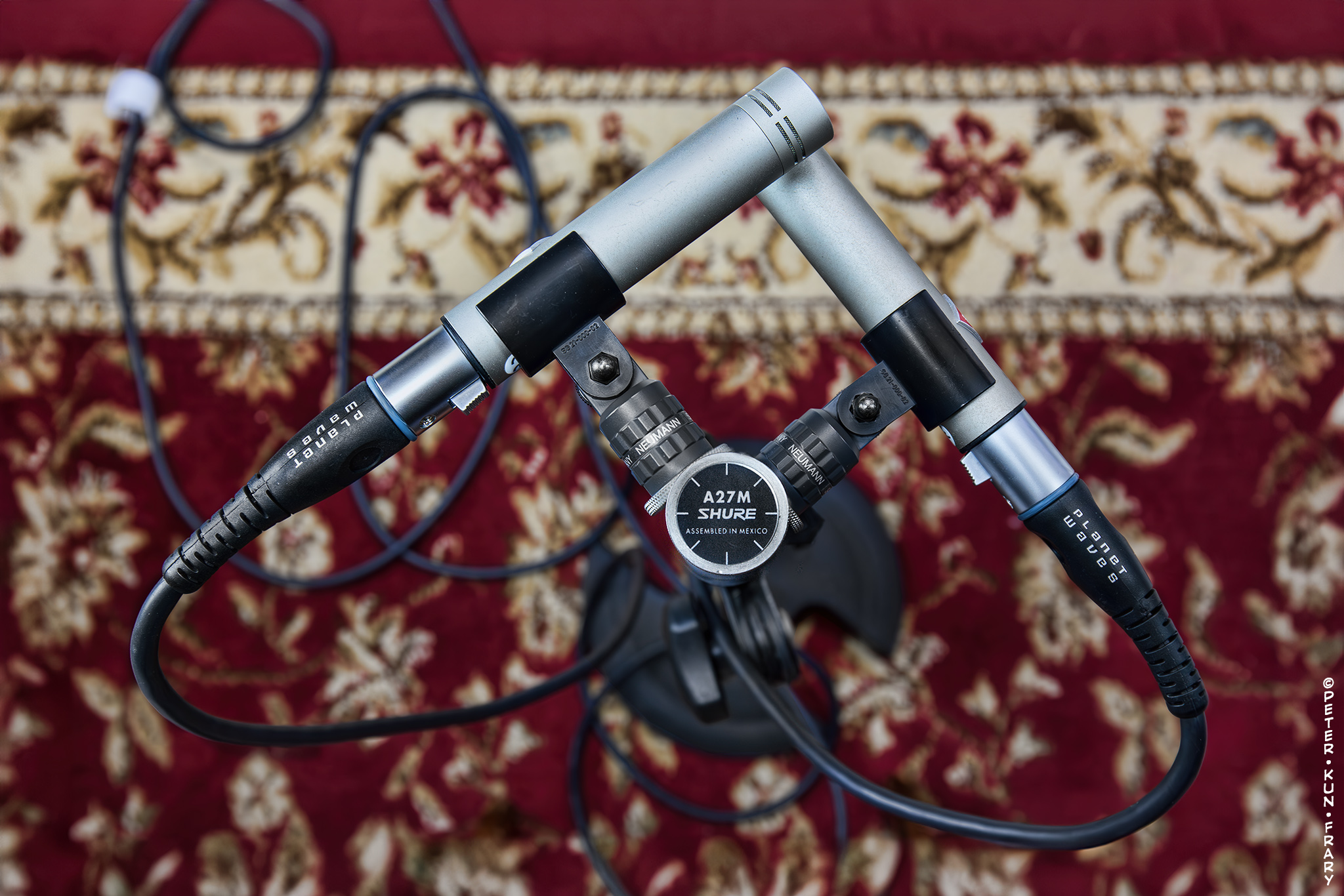. Neumann KM 184Small-diaphragm cardioid condenser mics Peter Kun Frary. .
|
Proximity EffectThe KM 184 has very little proximity effect. Plus, no matter what distance I am from the capsule, timbre stays about the same. Thus, I can use close mic placement and still get a natural sound from my guitar. I record in less than ideal conditions, i.e., my bedroom, so close miking along with the cardioid polar pattern's excellent background rejection allows me to get clean and vivid recordings. |
 |
Minuet in G (Bach) | Peter Kun Frary | Tiny Tenor 6 String Koa | Neumann KM 184 mics, Tascam US 4x4, Logic Pro X.
Frary Guitar Duo | Duo Op. 55 No. 3 (Sor) | Tascam DR-60D MKII (Wav 48K and 24-bit stereo) | Neumann KM184 (2X) | EOS 80D
Peter Frary | Sor's Etude Op. 60 No. 14 | 80D, EF-s 15-85 3.5-5.6 IS USM, Tascam DR-60D MKII (Wav 48K and 24-bit stereo) and Neumann KM-184 mics
Live Sound
The KM184 makes a great stage mic for acoustic and classical guitar. Unlike many recording mics, these are tiny, robust and have ample output. Bring your own clip because they are too small to fit most stage mic clips.
Neumann KM 184 | X-Y configuration with Shure A27M

Malagueña | Kremona Mari Tenor recorded with a Tascam US 2x2, Neumann KM184 (2X), small percussion and Logic Pro X
RFI Resistance
Here in RFI infested downtown Honolulu, I encountered no static, clicks or rogue radio stations while using the KM184 on my Tascam audio recorder and audio interface.
 Spoken Word
Spoken Word
If you're interested in how the KM 184 compares to other mics, below are audio samples of most of the mics I've used for voiceovers. For the samples, I spoke from 8 to 10 cm away. Microphones were mounted on a boom clamped to a computer desk in a partially treated room. I recorded into TwistedWave at 48 kHz and 24-bits. Gain was staged at -12 dB. No processing or normalization was used. Mics were fitted with a foam pop filter unless otherwise noted.
If not interested in the mic comparison, click here to jump to the Final Blurb.
Neumann KM 184
Obviously, the KM 184 is not designed for close miking of spoken word: no protection from plosives and moving air. That doesn't mean the KM 184 won't sound good for spoken word, but use of a pop filter is mandatory.
The KM 184 is a sensitive and dynamic mic—why I like it for instruments—but with only a foam windscreen, plosives were out of control. I nixed plosives by speaking offset about 30 degrees but didn't like the duller sound. Finally, I added an external pop filter and that worked well enough to squeeze out a test track. The KM 184 is flattering for my voice: smooth, clear and very clean. As I experienced with guitar, off-axis rejection of sound is excellent.
Would I use this mic for voiceovers? Probably not. It is extremely sensitive and requires good vocal technique to keep plosives and dynamics under control. Somebody with better voice technique may find it doable but the KM 184 cramped my style. With that said, the KM 184 is my pick for best spoken word sound among my mics. My favorite for solo guitar tracks as well.
For this recording, the KM 184 was plugged into the XLR port of the Rode Streamer X. Output from the KM 184 is robust: gain was set to only 36 dB, lower than my other condenser mics.
Lewitt LCT 240 Pro
The Lewitt LCT 240 Pro was plugged into the XLR input of the Rode Streamer X. Gain was set to 47 dB. This is a small diaphragm side-address condenser mic designed for home studios. It's an attractive and compact design, especially the effective yet space saving magnetic drop-in pop filter.
The 240 Pro flatters my voice with a pleasing but somewhat bright timbre and above average clarity and legibility of words. With the pop filter, plosives and sibilance were well controlled. Without the pop filter, the 240 Pro sounds like a wind storm. Wear protection!
While the bright character makes for clear and understandable words, it also makes the 240 Pro more prone to picking up background sounds than many of the mics here, save for the Neumann TLM 102.
Without accessories, the 240 Pro is priced at $100 USD. The shock mount and pop filter kit clock in at $159.
Rode NT1 Signature Series
The Rode NT1 Signature Series Studio Condenser Microphone (5th generation), circa 2024, is a large-diaphragm side-address condenser mic. It's been in production for many years, existing in multiple variants. It currently sells for $159 USD. It has a smooth and fairly flat response, a slight bump in the upper frequencies, and exhibits excellent clarity, detail, and slightly less bass than the 4th-generation NT1 that preceded it.
The NT1 was recorded through the Rode Streamer X with gain at 35 dB.
Rode PodMic USB
I plugged the XLR output of the Rode PodMic USB into the Rode Streamer X and set gain to 63 dB. The Rode PodMic, along with the Shure SM7B, rule over the video blogging and podcast kingdoms. Of course, they sound good and offer excellent isolation but also are large and visually impressive status mics.
Although vocal tone sounds nice, I struggled with plosives and sibilance when using the PodMic USB. Somehow the Shure SM57 and 849 have fewer problems in this area. An external pop filter and 30 to 45 degree mouth angle were required to keep plosives and sibilance under control. I prefer the tone speaking straight into the mic but suffered too many do-overs.
The PodMic USB retails for $200 USD.
Neumann TLM 102
One of my favorite mics for recording classical guitar is the Neumann TLM 102, a large diaphragm side-address condenser mic. Pointed at the bridge, it renders a beautiful and sweet plucked string tone. For guitar, it needs little or no EQ.
While great sounding for voice—smooth and natural in character and flattering to my voice—it is extremely sensitive to mouth sounds and puffs of air. I used a foam filter from the Deity VO-7U to help control plosives. That wasn't enough so I added a clamp-on pop filter but still had to be careful while speaking.
The TLM 102 is also more sensitive than average to vibrations from the floor, computer fans and off-axis sounds! I used a clone of Neumann's shock mount to help nix vibrations. It is unusable without a shock mount.
I recorded the Neumann TLM 102 through the XLR input of the Rode Streamer X. Gain was set at 46 dB. The TLM 102 is at its best in an acoustically treated and soundproof room.
Currently, the 102 retails for $750 USD.
Sennheiser MKE 600
That was the unprocessed sound of the Sennheiser MKE 600 recorded into an iMac Pro using the XLR input of the Rode Streamer X. I spoke directly into the MKE 600—no offset—from 10 cm (4 inches) away. At that distance the proximity effect is apparent but still sounds good, similar in character to the MKE 400 but with more bass. Offset speaking of 25 to 45 degrees at close distance rolls off highs a little but not as severely as the MKE 400.
Spoken word on the MKE 600 sounds best at 30 cm (12") or closer. For me, the sweet spot is from 10 to 15 cm. At about 12 cm (5 inches) it yields a noticeably clearer, brighter and less bassy sound. For this sample, I used the high pass filter to reduce the rumble of a nearby AC unit and spoke from 12 cm away:
It helped reduced the rumble but ate too much of the bass in my voice.
While the MKE 600 has excellent off-axis rejection, it is extremely sensitive and picks up distant sounds directly in front of the capsule more readily than the MKE 400 and other mics I own. Careful mic placement is critical. The MKE 600 behaves like a traditional shotgun mic rather than an arm's length video blogger mic, and sounds good boomed 25 or 30 cm above a talking head.
The MKE 600 lacks the integral blimp-like housing used on the MKE 400 and 440. It needs a foam windscreen if speaking at close distances. With windscreen installed, the MKE 600 demonstrates excellent control of plosives and sibilance.
This mic retails for about $330 USD but is often discounted.
Shure 849
For this recording, I plugged the Shure 849 into the XLR port of the Rode Streamer X interface. Gain was set to 54 dB.
I bought a pair of Shure 849 condenser mics in the late 1990s to record classical guitar. This is an instrument mic—looks and sounds similar to the current SM137—with small diaphragm and minimal windscreen protection. It was too bright in the lower highs for classical guitar and is better suited for miking guitar amps and percussion.
The Shure 849 was surprisingly flattering for my voice: smooth, warm, clear and very clean. With a foam windscreen or pop filter, it is extremely forgiving of plosives and small puffs of air. Because it was designed for isolating and miking stage instruments, off-axis sound rejection is excellent.
Among the mics I tested, the 849, SM137, KSM8 and Beta 57A were the only mics that picked up no vibrations or hum from my hard drives and nearby AC units. These mics were designed for hand held use and, thus, have internal pneumatic shock mounts.
Shure Beta 27
That was the sound of the Shure Beta 27, a large diaphragm side-address FET condenser mic with multiple high pass filters and pad. It differs from other 27 series due to a supercardioid polar pattern, rather than cardioid, and a nearly flat frequency response instead of the typical Shure treble EQ bump.
That flat frequency contour makes it ideal for instruments. Indeed, it sounds natural and smooth for guitar and ukulele. I found it natural and balanced for spoken word. The Beta 27 has more going on in the deep bass than most mics. Indeed, it picks up bass guitar, low brass and kick drums extremely well.
While mounted on a desk boom arm, vibrations and hum from my six external hard drives leaked on to the tracks. Shure claims that the Beta 27 has an internal shock mount but it is not as effective at nixing vibrations as their stage mics. Like the PodMic USB and the Neumann TLM 102, I had to unplug my backup drives to get a clean track. The Beta 27 needs a shock mount for desktop use.
Shure Beta 27 with High Pass Filter
For my speaking voice, not much is going on below 80 Hz and, set flat, the Beta 27 has a bit of the "big bottom" sound. Clarity of my voice increased slightly by using the built-in 80 Hz high pass filter:
The Beta 27 was recorded through the Rode Streamer X with preamp gain at 50 dB. I spoke straight into the capsule from about 15 cm (6 inches). The mic’s 3-layer mesh grille did a good job of nixing plosives and mouth noise. An external pop filter was not used. Sibilance was well controlled.
For this sample, I used the Shure A27SM - ShureLock Rubber Isolated Suspension Shock Mount. And it made a major improvement in isolating the Beta 27 from my six external hard drives. Shure should have included the A27SM with the Beta 27 (they do with its near twin, the SM27).
The tight supercardioid polar pattern made for above average off-axis rejection of sound, besting most of my mics. Unlike the similar SM27, the Beta 27 is ideal for recording on stages and untreated rooms.
Shure Beta 27 with Guitar
Here's a guitar solo I played on a 1990 Jose Ramirez 1A. The Beta 27 is positioned about 20 cm from the treble side of the bridge and does a great job. However, I prefer the sound of small condenser mics—well, the Neumann KM 184—for classical guitar. Plus, I'd need two Beta 27 for stereo recordings! Here's my "Thoughts for Monday" (improvisation):
This mic retails for about $400.
Shure Beta 57A
You just heard the sound of the Shure Beta 57A plugged into the XLR input of the Rode Streamer X. Grain was set to 63 dB.
Beta 57A isolation from off-axis sound is excellent: better than the Rode PodMic USB and on par with the Shure 849 and SM137. The 57A features Shure's internal pneumatic shock mount to help smooth away vibrations and handling noise.
With the Shure A57AWS - Locking Foam Windscreen installed, resistance to plosives is highly effective, easily besting the Rode PodMic USB in this regard. Without the A57AWS, it is plosives galore albeit better than a nude SM57.
Sound is smooth, clear and sensitive for a dynamic mic. Clarity and legibility of words is above average—can cut through a busy sound track without cranking gain too much. The Beta 57A has a brighter character and more extended frequency range compared to the darker voiced SM57.
Although the Beta 57A is slender and traditional in appearance, the muted matte blue finish and matte silver grill are more upscale in appearance compared to the plain jane SM57.
The Beta 57A retails for $150 USD.
Shure SM57
The iconic Shure SM57 was recorded through the XLR port of the Rode Streamer X with gain at 67dB. It requires more gain than most mics, albeit not as gain hungry as the SM7B. Like the SM58, the SM57 sports an internal pneumatic shock mount to smooth away minor vibrations. It has excellent rejection of off-axis sound.
Designed as an instrument mic, the SM57 is legendary in the rock world for miking guitar amps and drums. It lacks a pop grill, so I installed the Shure A2WS Popper Stopper Locking Windscreen.
For this track, I spoke straight into the mic from 10 cm away. If you prefer less brightness, speak offset to the capsule. This nearly indestructible mic sounds great: warm, smooth and easy on plosives. SM57 tone is more flattering for my voice than the Rode PodMic USB.
The SM57 retails for $99 USD.
Shure SM137
For this recording, I plugged the Shure SM137 into the XLR socket of the Rode Streamer X and set gain to 47dB. The Shure A3WS Foam Windscreen was installed. Like the Beta 57A and 849, the SM137 has excellent rejection of background and handling noise. Indeed, Shure's pneumatic shock mount system smooths away minor vibrations and makes hand held use practical. Albeit slightly brighter, it sounds similar and looks like the Shure 849. The SM137 retails for $190 USD.
Rode X Streamer | Mounted on a Manfrotto arm for easy port access.

 Final Blurb
Final Blurb
Does it deliver a natural “what you hear is what you get” sound? For classical and acoustic guitars, they are close. And, for ukulele, they're just about perfect. The KM184 are the first mics I reach for and I'm pleased with them: impeccable fit and finish, natural and balanced sound and clean output.
Finally, please help support this website by purchasing this item at Amazon.
Peter Kun Frary | Allemande | Tascam DR-60 MKII, Neumann KM184 (2X) and EOS 80D
 Features
Features
• Cardioid pattern
• 20 Hz to 20 kHz response
• 50 ohms impedance
• 13 dB-A of self-noise
• SPLs of 138 dB
• Transformerless circuitry
• 107 mm x 22 mm
• 80 g
Included accessories
• Wood storage box
• Clips
• Windscreen
12/15/2015 | 08/30/2024 Update
©Copyright 2015-2025 by Peter Kun Frary | All Rights Reserved



